Classification of the Major Taxa of Fish
Classification of the Major Taxa of Fish
Classification of the Major Taxa of Fish
You also want an ePaper? Increase the reach of your titles
YUMPU automatically turns print PDFs into web optimized ePapers that Google loves.
Station 1. <strong>Fish</strong> Diversity<br />
<strong>Classification</strong> <strong>of</strong> <strong>the</strong> <strong>Major</strong> <strong>Taxa</strong> <strong>of</strong> <strong>Fish</strong><br />
! Phylum Chordata examples<br />
! Subphylum Vertebrata<br />
! Supraclass Agnatha jawless fishes<br />
! Order Osteostraci<br />
! Order Anaspida<br />
! Order Heterostraci<br />
! Order Coelolepida<br />
! Order Cyclostomata<br />
! Class Myxinoidea hagfish<br />
! Class Petromyzontida lampreys<br />
! Class Placodermi<br />
! Order Arthrodiriformes<br />
! Order Antiarchiformes<br />
! Supraclass Gnathostomata jawed fishes<br />
! Class Chondrichthyes<br />
! Subclass Elasmobranchii<br />
! Order Cladoselachiformes extinct Paleozoic sharks<br />
! Order Xenacanthiformes Paleozoic freshwater sharks<br />
! Order Selachii typical sharks<br />
! Order Batoidea skates and rays<br />
! Subclass Holocephali<br />
! Order Chimaeriformes chimaeras or ratfishes<br />
! Class Acanthodii various extinct fishes<br />
! Class Osteichthyes higher bony fishes<br />
! Subclass Actinopterygii ray-finned fishes<br />
! Infraclass Chondrostei sturgeon, paddlefish; primitive ray-finned fishes<br />
! Infraclass Holostei gars, bowfins; dominant ray-finned fishes <strong>of</strong> Mesozoic<br />
! Infraclass Teleostei most bony fish; dominant in Cenozoic and recent times<br />
! Subclass Sarcopterygii lobe-finned fishes<br />
! Order Crossopterygii ancestors <strong>of</strong> land vertebrates<br />
! Order Dipnoi lungfishes
Station 1. <strong>Fish</strong> Diversity<br />
CLASS: AGNATHA<br />
JAWLESS FISHES<br />
includes <strong>the</strong> living forms LAMPREYS and HAGFISHES, and several<br />
extinct forms<br />
The jawless fish (supraclass Agnatha; a = without, gnathos = jaws) include <strong>the</strong> extinct<br />
ostracoderms and <strong>the</strong> living lamprey eels and hagfishes. Ostracoderms, <strong>the</strong> earliest<br />
known fossil chordates, have been found in <strong>the</strong> rocks <strong>of</strong> <strong>the</strong> Ordovician, Silurian and<br />
Devonian periods, These jawless fish were small, armored, bottom-dwelling freshwater<br />
filter feeders. The head was covered with thick bony plates, and <strong>the</strong> trunk and tail were<br />
covered with thick scales. Ostracoderms had median fins; some species had paired<br />
pectoral fins.<br />
The living relatives <strong>of</strong> <strong>the</strong> Ostracoderms are <strong>the</strong> lampreys and hagfishes. These<br />
animals have cylindrical bodies up to a meter long supported by a cartilaginous skeleton.<br />
Their smooth skin lacks scales, and <strong>the</strong>y have nei<strong>the</strong>r jaws nor paired fins. Most hagfish<br />
eat worms and o<strong>the</strong>r invertebrates, which <strong>the</strong>y burrow for or prey on dead and disabled<br />
fish.<br />
lamprey<br />
hagfish
Station 1. <strong>Fish</strong> Diversity<br />
CLASS: PETROMYZONTIDA<br />
Relevant features:<br />
nostril!<br />
olfactory!<br />
organ!<br />
pineal eye!<br />
brain!<br />
dorsal!<br />
aorta!<br />
digestive!<br />
pharynx!<br />
LAMPREYS<br />
•! anadromous and freshwater; cool zones <strong>of</strong> world<br />
•! one or two dorsal fins are present<br />
•! eyes well developed<br />
•! dorsal and ventral nerve roots separated<br />
•! sucking mouth; barbels absent; rasping teeth on oral disc and tongue<br />
•! small cerebellum<br />
•! sexes separate<br />
•! eggs small, not yolky, occurring in <strong>the</strong> thousands; larval stage<br />
undergoes radical metamorphosis in fresh water<br />
•! die shortly after spawning<br />
horny !<br />
teeth!<br />
sucking !<br />
mouth!<br />
rasping !<br />
aortic !<br />
tongue!<br />
arches!<br />
ventral!<br />
aorta!<br />
breathing!<br />
pharynx!<br />
gill !<br />
slit!<br />
pericardial!<br />
cartilage!<br />
ventricle!<br />
nerve !<br />
chord!<br />
atrium!<br />
notochord!<br />
liver!<br />
intestine!<br />
peritoneum!<br />
Lamprey structure<br />
gonad!<br />
coelom!<br />
European river lamprey, Lampetra fluviatilis<br />
mouth !<br />
opening!<br />
•! parasitic (freshwater or anadromous) or non-parasitic (only freshwater)<br />
tongue!<br />
disc!<br />
teeth!<br />
infra-oral!<br />
tooth plate!<br />
Oral disc and teeth <strong>of</strong> lamprey
Station 1. <strong>Fish</strong> Diversity<br />
CLASS: MYXINI<br />
Relevant features:<br />
HAGFISHES<br />
A polybranchiate hagfish, Eptatretus stoutix<br />
•! marine; temperate zones <strong>of</strong> <strong>the</strong> world<br />
•! no cerebellum<br />
•! eyes are degenerate, lens absent<br />
•! barbels present around biting mouth<br />
•! teeth only on tongue plus one on palate<br />
•! <strong>the</strong> dorsal fin is absent; <strong>the</strong> caudal fin extends<br />
onto part <strong>of</strong> <strong>the</strong> dorsal surface<br />
•! dorsal and ventral nerve roots united<br />
•! numerous mucus pores along body expel a slimy substance (hence nickname “slime eels”), for<br />
feeding and defense<br />
•! can go through knotting movements to free <strong>the</strong>mselves from entanglement and own slime<br />
•! ovaries and testes in same individual, but only one functional (not hermaphrodite)<br />
•! eggs large, yolky, up to 30 per individual; no metamorphosis<br />
•! <strong>the</strong> external nasohypophysial opening is terminal, and it is through this opening that respiratory<br />
water passes backward to <strong>the</strong> gills (unlike lampreys)<br />
•! scavenger feeders, mostly eating dying or dead invertebrates and o<strong>the</strong>r fishes<br />
•! only vertebrate in which <strong>the</strong> body fluids are isosmotic with seawater
Station 1. <strong>Fish</strong> Diversity
Station 1. <strong>Fish</strong> Diversity
Station 1. <strong>Fish</strong> Diversity<br />
CLASS: CHONDRICHTHYES<br />
Relevant features:<br />
•! marine, though some in deltas or freshwater<br />
•! cartilaginous skeleton<br />
•! five to seven gill slits<br />
SHARKS<br />
•! shark skin made up <strong>of</strong> denticles (placoid scales) for protection<br />
and for increased hydrodynamics<br />
•! lack swim bladder, so need to keep swimming to<br />
avoid sinking<br />
•! most are predatory, but some are filter feeders <strong>of</strong> plankton<br />
•! large olfactory bulb for excellent smelling<br />
•! efficient intestine with spiral structure<br />
•! internal fertilization<br />
•! most bear live young<br />
•! replaceable teeth in multiple rows along edges <strong>of</strong> upper<br />
and lower jaws, moving forward as needed.<br />
•! lower teeth are primarily used for holding prey, while <strong>the</strong><br />
upper ones are used for cutting into it.!<br />
lower!<br />
upper!<br />
side!<br />
front!<br />
Examples <strong>of</strong> Shark Teeth!<br />
upper!<br />
second !<br />
dorsal fin!<br />
claspers!<br />
(male)!<br />
Spiny Dogfish! White Shark! Thresher Shark! Hammerhead Shark! Tiger Shark!<br />
lower!<br />
upper!<br />
lower!<br />
upper!<br />
lower!<br />
Shark skin denticles!<br />
seminal !<br />
vesicle!<br />
anus!<br />
cloaca!<br />
first!<br />
dorsal fin!<br />
pelvic fin!<br />
Make sure to!<br />
look in microscope !<br />
to see shark skin !<br />
denticles up close!<br />
pectoral fin!<br />
vas deferens!<br />
lateral line!<br />
testis ! vertebrae!<br />
stomach! gall !<br />
intestine!<br />
bladder!<br />
external gill !<br />
opening!<br />
brain!<br />
heart!<br />
gills!<br />
rostrum!<br />
nostril!<br />
mouth!<br />
olfactory !<br />
bulb!
Station 1. <strong>Fish</strong> Diversity<br />
lower!<br />
CLASS: CHONDRICHTHYES<br />
Sharks, Rays, and Skates<br />
•! one <strong>of</strong> <strong>the</strong> two groups <strong>of</strong> true fishes (o<strong>the</strong>r is bony fish)<br />
•! skeletons are made <strong>of</strong> cartilage, hardened by lime<br />
•! about 600 species<br />
•! mostly marine<br />
•! most give birth to live young!<br />
A skate egg case. These may be found<br />
on almost any empty beach. Skates lay<br />
eggs, each in a horning container, nearly<br />
all year round. They hatch in 5 to 6<br />
months. Egg cases vary in size from<br />
about 3 to 6 in. long.
Station 1. <strong>Fish</strong> Diversity<br />
CLASS: OSTEICHTHYES<br />
Evolution <strong>of</strong> Bony <strong>Fish</strong>es<br />
CHONDROSTEI<br />
RAY-FINNED<br />
FISHES<br />
LOBE-FINNED<br />
FISHES<br />
Butterfishes<br />
(Coelacanths)<br />
Searobins<br />
Flounders<br />
Remoras<br />
Gars<br />
Filefishes Clingfishes<br />
Toadfishes<br />
Batfishes<br />
Gobies<br />
Mackerels<br />
Blennies<br />
Barracudas
Station 1. <strong>Fish</strong> Diversity<br />
Bony <strong>Fish</strong>es<br />
CLASS: OSTEICHTHYES<br />
•! one <strong>of</strong> <strong>the</strong> two groups <strong>of</strong> true fishes (o<strong>the</strong>r is Chondrichthyes)<br />
•! includes ray-finned fishes and lobe-finned fishes<br />
•! about 30,000 species<br />
•! live in any watery habitat<br />
•! most are covered in scales<br />
•! gills covered by flap<br />
•! have swim bladder for buoyancy<br />
•! usually lay eggs that are <strong>of</strong>ten fertilized externally<br />
Spotted grouper<br />
Clownfish fanning eggs<br />
Black-tipped rock cod<br />
Shown here are some members <strong>of</strong> <strong>the</strong> Serranidae<br />
family <strong>of</strong> carnivorous saltwater fishes. This family<br />
contains fish that are a valuable food source for<br />
many human residents <strong>of</strong> <strong>the</strong> tropics and subtropics.
Station 2. Skeletal<br />
THE SKELETAL SYSTEM<br />
To <strong>the</strong> left is <strong>the</strong> skeleton <strong>of</strong> a gar or bowfin (Holostei) and to <strong>the</strong> right is a skeleton <strong>of</strong><br />
a perch (Teleostei). Teleosts have superior trophic and locomotor adaptations.<br />
Look at <strong>the</strong> differences in <strong>the</strong> thickness <strong>of</strong> <strong>the</strong> bones and <strong>the</strong> structure <strong>of</strong> <strong>the</strong> jaws in<br />
<strong>the</strong> two fish. Why do you think <strong>the</strong> Holosteans are more primitive?<br />
Note that <strong>the</strong> Holostean has a more primitive firm biting jaw, while <strong>the</strong> perch has a jaw<br />
specialized for suction feeding. Most teleosts feed by expanding <strong>the</strong> anterior bones<br />
<strong>of</strong> <strong>the</strong> upper jaw to produce a strong suction force into <strong>the</strong> mouth. !<br />
(Roi Holzman - UC Davis)<br />
Suction feeding is perhaps <strong>the</strong> most common prey capture<br />
strategy <strong>of</strong> fishes. During suction feeding, <strong>the</strong> predator<br />
opens its mouth and rapidly expands its buccal cavity,<br />
generating a flow field external to <strong>the</strong> mouth. The rapid<br />
expansion <strong>of</strong> <strong>the</strong> buccal cavity produces high fluid<br />
velocities and accelerations that persist only a short<br />
distance from <strong>the</strong> mouth (about half <strong>of</strong> one mouth<br />
diameter), and for a short time (a few ms). Therefore, <strong>the</strong><br />
predator must carefully time its strike to maximize <strong>the</strong><br />
forces exerted on its prey.!
Station 2. Skeletal<br />
THE SKELETAL SYSTEM<br />
Skeleton <strong>of</strong> a Teleost<br />
Compare <strong>the</strong> skeleton <strong>of</strong><br />
this bony fish with that<br />
<strong>of</strong> a mammal - <strong>the</strong> rat.<br />
Unlike that <strong>of</strong> <strong>the</strong> skate,<br />
note <strong>the</strong> interlocking<br />
vertebrae <strong>of</strong> rat.<br />
Though it lacks bones,<br />
<strong>the</strong> vertebral column <strong>of</strong><br />
a skate shows<br />
elaborate calcification.
Station 3. Jaws<br />
The famous American Museum <strong>of</strong> Natural History<br />
reconstruction <strong>of</strong> jaws <strong>of</strong> <strong>the</strong> giant fossil shark<br />
Carcharodon megalodon. Overzealous preparators<br />
in <strong>the</strong> museum’s Department <strong>of</strong> Vertebrate<br />
Paleontology (shown framed by <strong>the</strong>ir handiwork in<br />
a 1909 photograph) used <strong>the</strong> largest teeth <strong>the</strong>y<br />
could find to make <strong>the</strong> most spectacular jaw. In<br />
living sharks, teeth diminish in size as <strong>the</strong>y<br />
approach <strong>the</strong> corners <strong>of</strong> <strong>the</strong> jaw, but <strong>the</strong><br />
preparators used teeth primarily from <strong>the</strong> anterior<br />
positions <strong>of</strong> <strong>the</strong> upper jaw, much exaggerating <strong>the</strong><br />
final reconstruction. Estimates <strong>of</strong> <strong>the</strong> length <strong>of</strong><br />
Carcharodon megalodon have ranges from 60 to<br />
100 ft.<br />
JAWS<br />
Compare <strong>the</strong> shark jaw with that <strong>of</strong><br />
<strong>the</strong> bony fish. The shark’s jaw is<br />
made <strong>of</strong> cartilage. Now look at <strong>the</strong><br />
jaw <strong>of</strong> a skate, ano<strong>the</strong>r cartilaginous<br />
fish. Notice <strong>the</strong> difference in <strong>the</strong> teeth<br />
<strong>of</strong> this animal that feeds on mollusks.<br />
Like o<strong>the</strong>r sharks, this sand<br />
tiger shark’s teeth fall out<br />
when <strong>the</strong>y become worn or<br />
snagged on prey. Lost teeth<br />
are quickly replaced by new<br />
ones lined up right behind<br />
<strong>the</strong> old ones.<br />
A regression <strong>of</strong> tooth size on actual body length<br />
for <strong>the</strong> living Carcharodon carcharias indicates<br />
by extrapolation that Carcharodon megalodon<br />
was “only” 43 ft in length! (Randall, J. E., Science,<br />
181: 169-170.)
Station 3. Jaws<br />
JAWS<br />
The teeth <strong>of</strong> Elasmobranchs are modified placoid scales, and are continuously shed and replaced.<br />
The teeth <strong>of</strong> bony fish resemble those <strong>of</strong> most vertebrates, and consist <strong>of</strong> dentin and enamel.<br />
This jaw <strong>of</strong> a Port Jackson shark shows <strong>the</strong> distribution<br />
and varieties <strong>of</strong> shark teeth. The placoid scales exhibit a<br />
gradual transition to teeth as <strong>the</strong>y approach <strong>the</strong> front <strong>of</strong><br />
<strong>the</strong> jaw.<br />
This unerupted tooth <strong>of</strong> a garfish shows <strong>the</strong><br />
development <strong>of</strong> teeth in bony fish. Tooth germ is<br />
a replacement for a tooth that will be shed.
Station 4. Locomotion<br />
LOCOMOTION<br />
<strong>Fish</strong> are superbly adapted to live in water. Water has main two features to which fish have had to<br />
adapt.<br />
1) Water is dense. It is about 800 times denser than air.<br />
a) This affects fish by supporting weight well.<br />
b) However, it also makes it harder for fish to brea<strong>the</strong>. <strong>Fish</strong> use 10% <strong>of</strong> its<br />
energy ventilating its gills, whereas a human uses only 3% <strong>of</strong> its<br />
energy to ventilate his lungs.<br />
2) Water is incompressible. Any water particle that moves causes <strong>the</strong> particle next to it to<br />
move as well. <strong>Fish</strong> have capitalized on this:<br />
a) Their lateral line senses water movement and vibration. The lateral-line<br />
system helps <strong>the</strong> fish to avoid collisions, to orient itself in relation to<br />
water currents, and to locate prey.<br />
The lateral line <strong>of</strong> a catfish!<br />
b) When feeding, water, along with food, can be sucked into <strong>the</strong>ir mouth.
Station 4. Locomotion<br />
An abbreviated<br />
heterocercal<br />
tail <strong>of</strong> a bowfin<br />
A generalized<br />
homocercal tail<br />
(most bony fishes)<br />
FISH TAILS<br />
The tails <strong>of</strong> fishes reflect changes that have taken place through <strong>the</strong> ages. In sharks, as in early<br />
fossil fishes, <strong>the</strong> upper part <strong>of</strong> <strong>the</strong> tail contains <strong>the</strong><br />
backbone and extends to a point. This asymmetrical<br />
fin type is called heterocercal.<br />
Homocercal tail <strong>of</strong><br />
a striped bass<br />
A generalized heterocercal tail<br />
(sharks, sturgeon, fossil fishes)<br />
In modern bony fishes, <strong>the</strong> tail is more balanced and <strong>the</strong><br />
backbone ends where <strong>the</strong> tail begins. This type <strong>of</strong> caudal fin is<br />
called homocercal. The fin is external to <strong>the</strong> muscle mass <strong>of</strong> <strong>the</strong><br />
body and is very flexible. Lateral undulation <strong>of</strong> <strong>the</strong> tail produces a<br />
symmetrical force so that, toge<strong>the</strong>r with a well controlled air<br />
bladder, a teleost can swim horizontally without continuously employing its paired fins, reducing<br />
drag. Relieved <strong>of</strong> this function, <strong>the</strong> paired fins <strong>of</strong> teleosts<br />
became more flexible and diverse in size, shape, position.<br />
There is hardly a function for which teleost fins have not<br />
become adapted - from food getting to love making, from<br />
sound production to walking, and even flying. !
Station 4. Locomotion<br />
FISH TAILS<br />
Ano<strong>the</strong>r type <strong>of</strong> tail is called diphycercal or isocercal. In this type <strong>of</strong><br />
caudal fin, <strong>the</strong> vertebrae extend all <strong>the</strong> way to <strong>the</strong> end <strong>of</strong> <strong>the</strong> tail. It is<br />
present in coelacanth and lungfish, where<br />
it is three-lobed. It may be secondarily<br />
isocercal tail<br />
<strong>of</strong> a cod<br />
acquired from <strong>the</strong> homocercal condition by loss <strong>of</strong> <strong>the</strong> real caudal fin<br />
and <strong>the</strong> gaining <strong>of</strong> a new one from dorsal and anal elements.<br />
Isocercal tail <strong>of</strong><br />
a coelocanth<br />
A protocercal type <strong>of</strong> caudal fin extends around <strong>the</strong> vertebral column. It is present in embryonic<br />
fish and in hagfish.<br />
protocercal tail <strong>of</strong><br />
a hagfish
Station 4. Locomotion<br />
BUOYANCY<br />
How do fish overcome gravity? <strong>Fish</strong> will sink unless <strong>the</strong>y ei<strong>the</strong>r have some kind <strong>of</strong> float or <strong>the</strong>y<br />
produce vertical lift by propulsive movements.<br />
In <strong>the</strong> first case, neutral buoyancy is found in most bony fishes in <strong>the</strong> from <strong>of</strong> a swim bladder.<br />
The swim bladder is gas-filled and lies below <strong>the</strong> vertebral column. Though cartilaginous<br />
fishes lack a swim bladder, some have a large fatty liver that provides some buoyancy.<br />
Many pelagic (deep sea) fishes like tuna, mackerel, swordfish, and <strong>the</strong> cartilaginous fishes<br />
lack swim bladders. These fishes must swim constantly in order to produce<br />
sufficient lift. This is done by extending <strong>the</strong> pectoral fins like wings,<br />
with forward thrust provided by <strong>the</strong> caudal fin. The dorsal and ventral<br />
fins reduce <strong>the</strong> tendency to roll and yaw. They also assist in turning<br />
movements. The pectoral and pelvic fins act as hydroplanes and<br />
control <strong>the</strong> pitch. The tail fin contributes to <strong>the</strong> forward thrust.<br />
Compare <strong>the</strong> forces associated with a fish swimming and a bird flying.<br />
Yaw<br />
FISH BIRD<br />
GRAVITY Center <strong>of</strong><br />
Pitch<br />
Roll<br />
gravity<br />
Center <strong>of</strong><br />
gravity<br />
DRAG THRUST DRAG<br />
THRUST<br />
LIFT and<br />
BUOYANCY<br />
Keel<br />
Lateral<br />
propulsive motion<br />
Yaw<br />
Pitch<br />
Vertical<br />
propulsive<br />
motion<br />
GRAVITY<br />
LIFT<br />
Roll
Station 4. Locomotion<br />
Groupers <strong>of</strong>ten weigh hundreds <strong>of</strong> pounds. Yet, <strong>the</strong> buoyancy <strong>of</strong><br />
water and <strong>the</strong> fish’s swim bladder allow it to hover as if weightless.!
Station 4. Locomotion<br />
SHARK SKIN<br />
Features <strong>of</strong> shark skin itself improves <strong>the</strong> hydrodynamics <strong>of</strong><br />
this swimmer. Shark skin is made <strong>of</strong> tiny, hard, tooth-like<br />
structures called dermal denticles or placoid scales. These<br />
structures are shaped like curved, grooved teeth. Like teeth,<br />
<strong>the</strong>y have an outer layer <strong>of</strong> enamel, dentine and a central pulp<br />
cavity. Unlike <strong>the</strong> scales <strong>of</strong> bony fish (ctenoid scales) that get<br />
larger as <strong>the</strong> fish grows, placoid scales stay <strong>the</strong> same size. As<br />
<strong>the</strong> shark grows, it just grows more placoid scales.<br />
These scales also help <strong>the</strong> shark swim more quickly because<br />
<strong>the</strong>ir streamlined shapes reduces drag by channeling it<br />
through grooves. All <strong>of</strong> <strong>the</strong> spines <strong>of</strong> <strong>the</strong> denticles point<br />
backwards (towards <strong>the</strong> tail), so it feels relatively smooth if you<br />
move your hand from head to tail, but rough <strong>the</strong> o<strong>the</strong>r way.<br />
SHARK SKIN TECHNOLOGY<br />
Because <strong>of</strong> its usefulness in improving hydrodynamics, engineers have<br />
developed several products modeled on <strong>the</strong> shark skin. Special “Sharkskin”<br />
swim suits havebeen developed by Speedo to give Olympic swimmers<br />
a competitive advantage.<br />
Shark placoid scale!<br />
Cal Olympian Natalie Coughlin<br />
wearing a Sharkskin swimsuit<br />
The US Navy has even developed a special coating to put on <strong>the</strong>ir ships that mimics shark<br />
skin. It reduces <strong>the</strong> amount <strong>of</strong> algae and barnacle buildup that accumulates on ships in dock,<br />
which reduces drag and <strong>the</strong>refore fuel usage.
Station 5. <strong>Fish</strong> Oddities<br />
FISH ODDITIES<br />
“Warm-blooded”<br />
Tuna and pelagic shark have<br />
musculature 10 degrees warmer than<br />
<strong>the</strong> surrounding sea.<br />
Changing sex<br />
Most reef fishes can change<br />
<strong>the</strong>ir sex. There are many<br />
different patterns for sex<br />
-change. Some species will<br />
begin life as males and switch<br />
to females (protandry), and<br />
o<strong>the</strong>rs switch from female to<br />
male (protogyny). Fur<strong>the</strong>r still,<br />
some will change sex in both<br />
directions, and o<strong>the</strong>rs will be<br />
both sexes at <strong>the</strong> same time.!<br />
Flying fish<br />
A flying fish leaves <strong>the</strong> water with<br />
outstretched pectoral fins which, held<br />
rigid, will serve as wings during a<br />
prolonged, 35 mile-an-hour glide. Prior to<br />
flight, <strong>the</strong> tail served as a miniature<br />
outboard motor, beating back and forth<br />
as much as 50 times a second and<br />
helping lift <strong>the</strong> fish into <strong>the</strong> air. Flying<br />
fishes use <strong>the</strong>ir aerial skills as a way <strong>of</strong><br />
escaping from <strong>the</strong>ir enemies.<br />
Big Mouth<br />
The mouth <strong>of</strong> <strong>the</strong> carnivorous leaf fish <strong>of</strong> <strong>the</strong><br />
Amazon basin is well suited to satisfying its<br />
voracious appetite and its habit <strong>of</strong> yawning.<br />
From a normal position, <strong>the</strong> mouth can shoot<br />
forward to from a tube that sucks in tiny victims<br />
with <strong>the</strong> efficiency <strong>of</strong> a vacuum cleaner. In<br />
captivity a two inch leaf fish consumes at least<br />
1,000 one inch guppies each year.<br />
Scaleless<br />
Catfish possesses no scales. Their bodies are<br />
ei<strong>the</strong>r naked or covered in bony plates called<br />
scutes. In some species, <strong>the</strong> mucus-covered<br />
skin is used for cutaneous respiration.!
Station 5. <strong>Fish</strong> Oddities<br />
DEFENSE and PREDATION<br />
Porcupinefish (above) and Burrfish (below)<br />
are closely related to <strong>the</strong> puffers, but in<br />
addition to <strong>the</strong>ir ability to swell, <strong>the</strong>ir skin is<br />
covered with stout spikes that make <strong>the</strong>m<br />
more dangerous to o<strong>the</strong>r fishes and hard to<br />
handle. These are tropical fishes, usually<br />
found in shallow water where <strong>the</strong>y feed on<br />
small invertebrates.<br />
An active huntsman,<br />
<strong>the</strong> archerfish fires<br />
water at an insect by<br />
compressing its gill<br />
covers and forcing<br />
<strong>the</strong> water through a<br />
tiny tube formed by its<br />
tongue and palate.<br />
The archer’s<br />
accuracy is more<br />
amazing since it aims<br />
from under water and<br />
compensates for<br />
refraction. !<br />
Sargassumfish are<br />
small anglers that<br />
live in <strong>the</strong> floating<br />
sargassum (a<br />
macroalgae) beds<br />
<strong>of</strong> <strong>the</strong> warmer<br />
Atlantic. Their color<br />
and adaptations,<br />
such as <strong>the</strong> armlike<br />
pectoral fins,<br />
enable <strong>the</strong>m to<br />
thrive in this limited<br />
environment.!
Station 5. <strong>Fish</strong> Oddities<br />
Fewer fins<br />
Some fish have lost one set <strong>of</strong> fins,<br />
whereas o<strong>the</strong>rs, like <strong>the</strong> eel, have no fins.!<br />
FINLESS FISH<br />
Among <strong>the</strong> almost 600 species <strong>of</strong> eels are morays.<br />
Moray eels live along rocky coasts or near <strong>the</strong> ocean<br />
bottom in coral reefs. Some moray eels are fierce<br />
looking, especially <strong>the</strong> large ones that can grow up to ten<br />
feet long and weigh 75 pounds. They have powerful jaws<br />
and long, needle-sharp teeth. Their thick skin is covered<br />
with mucus instead <strong>of</strong> scales. The mucus protects it from<br />
scrapes as it moves about searching for prey in cracks<br />
and crevices <strong>of</strong> <strong>the</strong> coral reef. !<br />
Garden eels live on <strong>the</strong> sandy ocean floor in shallow water. They<br />
are shy creatures, and <strong>the</strong>y live toge<strong>the</strong>r in colonies in a very<br />
unusual way. Each eel burrows tail-first into <strong>the</strong> sand and lives in<br />
<strong>the</strong> burrow. When hungry, <strong>the</strong> garden eels come out <strong>of</strong> <strong>the</strong>ir<br />
burrows and, standing upright on <strong>the</strong> tips <strong>of</strong> <strong>the</strong>ir tails, swoop<br />
gracefully to catch fish eggs and tiny animals that float by. !
Station 5. <strong>Fish</strong> Oddities<br />
CAMOUFLAGE<br />
The blenny (above) and pricklebacks<br />
(right) live along coastlines, where <strong>the</strong>y<br />
<strong>of</strong>ten hide in holes in rocks. The weird<br />
plant-like objects on <strong>the</strong>ir heads are<br />
actually flaps <strong>of</strong> skin that help to<br />
camouflage <strong>the</strong>m.!<br />
The leafy sea dragon lives in <strong>the</strong> temperate, shallow waters<br />
<strong>of</strong> sou<strong>the</strong>rn and western Australia. Their leafy protrusions<br />
serve as camouflage among <strong>the</strong> seaweed.!
Station 5. <strong>Fish</strong> Oddities<br />
If you look closely at <strong>the</strong> picture <strong>of</strong> <strong>the</strong> waving<br />
sea grasses, you will spot some thin bay<br />
pipefish. !<br />
CAMOUFLAGE<br />
A flounder blends into <strong>the</strong> sandy sea floor. !
Station 5. <strong>Fish</strong> Oddities<br />
WALKING FISH<br />
The mudskipper and <strong>the</strong> walking<br />
catfish spend more time out <strong>of</strong> <strong>the</strong><br />
water than in, and <strong>the</strong> Australian<br />
lungfish drowns if kept under water.<br />
Australian lungfish<br />
Mudskippers (in <strong>the</strong> Goby family) are uniquely adapted to a completely amphibious lifestyle. Mudskippers are quite<br />
active when out <strong>of</strong> water, feeding and defending <strong>the</strong>ir territories. They have several anatomical and behavioral<br />
adaptations that allow <strong>the</strong>m to live well on land, including <strong>the</strong> ability to brea<strong>the</strong> through <strong>the</strong>ir skin and <strong>the</strong> lining <strong>of</strong><br />
<strong>the</strong>ir mouth and throat. They absorb oxygen through blood vessels just below <strong>the</strong>ir wet skin. They inhabit shallow<br />
tidal flats and mangrove swamps. They dig deep burrows in s<strong>of</strong>t sediments in order to <strong>the</strong>rmoregulate, to avoid<br />
marine predators during <strong>the</strong> high tide when <strong>the</strong> fish and burrow are submerged, and for laying <strong>the</strong>ir eggs. They hop<br />
along on <strong>the</strong>ir large pectoral fins, and can travel faster on land that a man can walk!
Station 5. <strong>Fish</strong> Oddities<br />
DEEPEST OF THE DEEP<br />
In <strong>the</strong> abyss, <strong>the</strong> only light comes from fish that glow.<br />
Some deep sea fish are bioluminescent. Like fireflies,<br />
<strong>the</strong>y create chemicals that glow when <strong>the</strong>y mix. Some<br />
<strong>of</strong> <strong>the</strong>se fish have special pockets in <strong>the</strong>ir bodies<br />
where <strong>the</strong>y carry bioluminescent bacteria. The fish<br />
look as if <strong>the</strong>y are glowing, but really it’s <strong>the</strong> bacteria.<br />
In o<strong>the</strong>r bioluminescent fish, <strong>the</strong>y contain specialized<br />
mitochondrial cells called photocytes. Some glowing<br />
fish use <strong>the</strong>ir light to catch prey. !<br />
The underside <strong>of</strong> <strong>the</strong> cookie cutter<br />
shark is bioluminescent, glowing a pale<br />
blue-green that matches <strong>the</strong> background<br />
light from <strong>the</strong> ocean's surface. This<br />
serves to camouflage it from creatures<br />
beneath it. However, a small non<br />
-luminescent patch appears black,<br />
deceiving <strong>the</strong> shark's prey, smaller<br />
predatory fish (like tuna), into thinking<br />
<strong>the</strong> shark is an even smaller fish. When<br />
<strong>the</strong> predatory fish tries to strike at <strong>the</strong><br />
shark, <strong>the</strong> shark strikes back, scoring<br />
itself ano<strong>the</strong>r meal.<br />
This angler fish dangles its lighted<br />
lure like bait on a fishing line. Curious<br />
creatures that come too close end up<br />
as <strong>the</strong> glowing fish’s dinner.
Station 5. <strong>Fish</strong> Oddities<br />
DEEPEST OF THE DEEP<br />
Chiasmodon<br />
Food is so rare at <strong>the</strong> lower levels <strong>of</strong> <strong>the</strong><br />
sea that when it does come along it<br />
must be taken advantage <strong>of</strong>. The<br />
chiasmodon will swallow victims larger<br />
than it is. To do this it must move its<br />
heart out <strong>of</strong> <strong>the</strong> way and turn its gills<br />
inside out. It gets its oversized meals<br />
down with <strong>the</strong> help <strong>of</strong> movable teeth in<br />
its throat. Its stomach stretches to hold<br />
victim twice its own size.<br />
Bristlemouths are well camouflaged. When<br />
deep sea animals look up toward <strong>the</strong> ocean's<br />
surface, <strong>the</strong>y see o<strong>the</strong>r animals overhead as<br />
dark shapes against a lighter background. But by<br />
lighting two rows <strong>of</strong> photophores on its<br />
underside, this deep sea fish avoids casting its<br />
shadow on predators below––and can virtually<br />
disappear.
Station
















